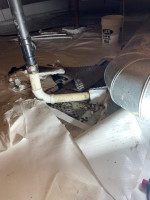Fermentables
|
Amount
|
Fermentable
|
Cost
|
PPG
|
°L |
Bill %
|
|
7.75 lb |
Viking - Oak Smoked Wheat7.75 lb Oak Smoked Wheat |
|
31 |
4.3 |
100% |
|
7.75 lbs / $ 0.00
|
Mash Guidelines
|
Amount
|
Description
|
Type
|
Start Temp
|
Target Temp
|
Time
|
|
11.63 qt |
Single Infusion |
Infusion |
160.2 °F |
149 °F |
60 min |
|
|
Mash out |
Temperature |
149 °F |
170 °F |
20 min |
|
|
|
Vorlauf |
-- |
-- |
15 min |
|
22.5 qt |
|
Batch Sparge |
-- |
170 °F |
15 min |
Starting Mash Thickness:
1.5 qt/lb
Starting Grain Temp:
65 °F |
Target Water Profile
Balanced Profile
| Ca+2 |
Mg+2 |
Na+ |
Cl- |
SO4-2 |
HCO3- |
|
60 |
7.5 |
9.5 |
40 |
37.5 |
25 |
Use oak-smoked wheat instead of beechwood smoked.
Rice Hulls:
Add 1lb for every 5 lbs of malt to help with heat distribution.
For a Piwo Grodziskie (Grätzer), a traditional Polish smoked wheat beer, the water profile should highlight the unique, subtle smokiness and maintain a soft, refreshing quality. This style benefits from a balanced, relatively low-mineral water profile. Here’s a suggested water profile to start with:
Calcium (Ca): 50–70 ppm (helps with yeast health and clarity without adding too much hardness)
Magnesium (Mg): 5–10 ppm (important for yeast health but should be kept low to avoid harshness)
Sodium (Na): 0–20 ppm (minimal sodium to keep flavors crisp and clean)
Sulfate (SO₄): 25–50 ppm (enough to add a hint of dryness but not enough to accentuate bitterness)
Chloride (Cl): 30–50 ppm (a touch of chloride will round out the body but should be restrained to avoid sweetening)
Bicarbonate (HCO₃): 0–50 ppm (minimal bicarbonate to keep the mash pH in check without adding harshness)
This soft water profile emphasizes a balanced, clean malt base, allowing the smoke character from the malt to shine without interference. |
|
Mash Chemistry and Brewing Water Calculator
|
Notes
Overall Impression: A low-gravity, bitter, oak-smoked historical central European wheat beer with a clean fermentation profile and no sourness. Highly carbonated, dry, crisp, and refreshing.
Aroma: Low to moderate oak wood smoke is the most prominent aroma component, but it can be subtle and complex. A low spicy, herbal, or floral hop aroma is typically present and should be lower than or equal to the smoke in intensity. Hints of grainy wheat are also detected in the best examples. The aroma is otherwise clean, although light pome fruit esters (especially ripe red apple or pear) are welcome. No acidity. Light sulfur is optional.
Appearance: Pale yellow to gold in color with excellent clarity. A tall, billowy, white, tightly knit head with fantastic retention is distinctive. Murkiness is a fault.
Flavor: Moderately low to medium oak smoke flavor up front, which carries into the finish; the smoke can be more robust in flavor than in aroma. The smoke character is gentle, should not be acrid, and can lend an impression of sweetness. A moderate to solid bitterness is readily evident, which lingers through the finish. The overall balance is toward bitterness. Low but perceptible spicy, herbal, or floral hop flavor. Low grainy wheat character in the background. Light pome fruit esters (red apple or pear) may be present—dry, crisp finish. No sourness.
Mouthfeel: Light in body, with a crisp and dry finish. Carbonation is relatively high and can add a slight carbonic bite or prickly sensation—no alcohol warmth.
Comments: Pronounced in English as “pivo grow-JEES-kee-uh” (meaning: Grodzisk beer) and known as Grätzer (pronounced “GRATE-sir”) in German-speaking countries and some beer literature and traditionally made using a multi-step mash, a long boil (~2 hours), and multiple ale yeast strains. The beer is never filtered, but Isinglass is used to clarify before bottle conditioning and is traditionally served in tall conical glassware to accommodate the vigorous foam stand.
History: It developed as a unique style centuries ago in the Polish city of Grodzisk (known as Grätz when ruled by Prussia and Germany). In the late 19th and early 20th centuries, its fame and popularity rapidly extended to other parts of the world. Regular commercial production declined after WWII and ceased in the 1990s. This style description describes the traditional version during its period of incredible popularity.
Characteristic Ingredients: Oak-smoked wheat malt, which has a less intense smoke character than German Rauchmalz, and a drier, crisper, leaner quality – a smoky bacon or ham flavor is inappropriate—traditional Polish, Czech, or German hops. Moderate hardness sulfate water. Clean, attenuative ale yeast; Weizen yeast inappropriate.
Style Comparison: Similar in strength to a Berliner Weisse, but never sour and much more bitter. It has a smoked character but is less intense than in a Rauchbier. It has lower gravity than a Lichtenhainer but is more bitter and not sour. It's more bitter than a Gose, but no salt and spices.
Vital Statistics: OG: 1.028 – 1.032
IBUs: 20 – 35 FG: 1.006 – 1.012
SRM: 3 – 6 ABV: 2.5 – 3.3%
Commercial Examples: Live Oak Grodziskie
Tags: session-strength, pale-color, top-fermented, central-Europe, historical-style, wheat-beer-family, bitter, smoke

Last Updated and Sharing

- Public: Yup, Shared
- Last Updated: 2024-11-15 20:04 UTC
For quick copying and pasting to a text based forum or email.
Click the Download as HTML file button below.
Recipe costs can be adjusted by changing the batch size. They won't be saved but will give you an idea of costs if your final yield was different.
|
Cost $ |
Cost % |
| Fermentables |
$ |
|
Steeping Grains
(Extract Only) |
$ |
|
| Hops |
$ |
|
| Yeast |
$ |
|
| Other |
$ |
|
| Cost Per Barrel |
$ 0.00 |
|
| Cost Per Pint |
$ 0.00 |
|
| Total Cost |
$ 0.00 |
|
Discussion about this recipe:
